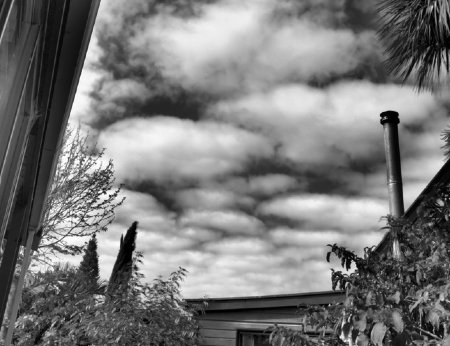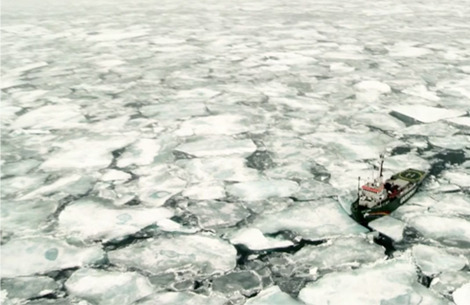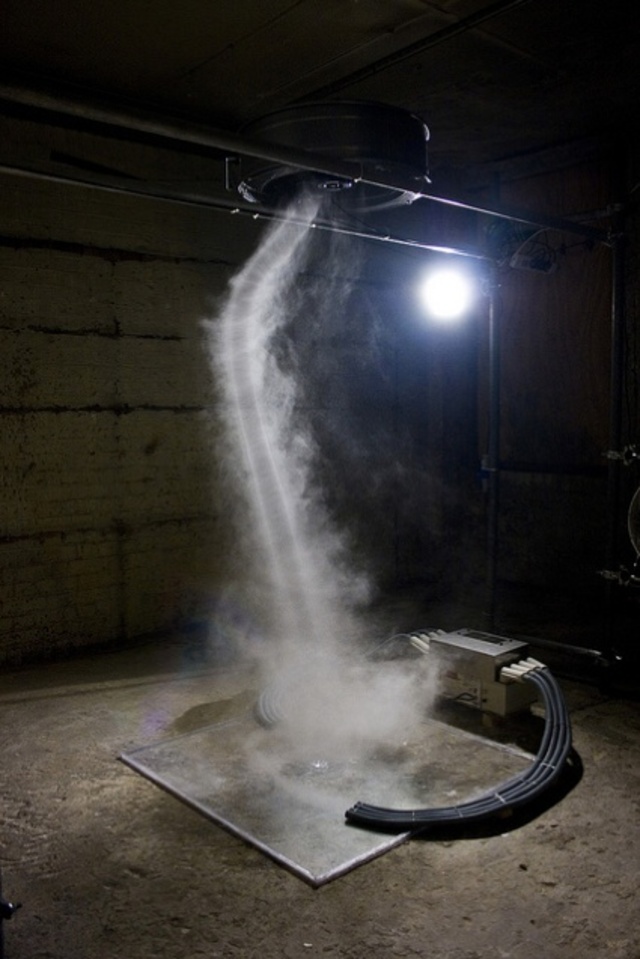Friday, November 25. 2011
(Image: Institute of Physics)
The future of augmented-reality technology is here - as long as you're a rabbit. Bioengineers have placed the first contact lenses containing electronic displays into the eyes of rabbits as a first step on the way to proving they are safe for humans. The bunnies suffered no ill effects, the researchers say.
The first version may only have one pixel, but higher resolution lens displays - like those seen in Terminator - could one day be used as satnav enhancers showing you directional arrows for example, or flash up texts and emails - perhaps even video. In the shorter term, the breakthrough also means people suffering from conditions like diabetes and glaucoma may find they have a novel way to monitor their conditions.
In February, New Scientist revealed the litany of research projects underway in the field of contact lens enhancement. While one company has fielded a contact lens technology using a surface-mounted strain gauge to assess glaucoma risk, none have built in a display, or the lenses needed for focused projection onto the retina - and then tested it in vivo. They have now.
"We have demonstrated the operation of a contact lens display powered by a remote radiofrequency transmitter in free space and on a live rabbit," says a US and Finnish team led by Babak Praviz of the University of Washington in Seattle.
"This verifies that antennas, radio chips, control circuitry, and micrometre-scale light sources can be integrated into a contact lens and operated on live eyes."
The test lens was powered remotely using a 5-millimetre-long antenna printed on the lens to receive gigahertz-range radio-frequency energy from a transmitter placed ten centimetres from the rabbit's eye. To focus the light on the rabbit's retina, the contact lens itself was fabricated as a Fresnel lens - in which a series of concentric annular sections is used to generate the ultrashort focal length needed.
They found their lens LED glowed brightly up to a metre away from the radio source in free space, but needed to be 2 centimetres away when the lens was placed in a rabbit's eye and the wireless reception was affected by body fluids. All the 40-minute-long tests on live rabbits were performed under general anaesthetic and showed that the display worked well - and fluroescence tests showed no damage or abrasions to the rabbit's eyes after the lenses were removed.
While making a higher resolution display is next on their agenda, there are uses for this small one, say the researchers: "A display with a single controllable pixel could be used in gaming, training, or giving warnings to the hearing impaired."
"This is clearly way off in the future. But we're aware of the research that is ongoing in this field and we're watching the technology's potential for biosensing and drug delivery applications in particular," says a spokesperson for the British Contact Lens Association in London.
Thursday, November 17. 2011
Via GOOD
-----
by Sarah Laskow

Not long ago, geoengineering was a verboten topic. It’s the sort of idea that dips deep enough into the wells of human ambition and hubris that it seems too dangerous to even consider. In the words of a Woodrow Wilson Center report, geoengineering “involves intentional, large-scale interventions in the Earth’s atmosphere, oceans, soils or living systems to influence the planet’s climate”—in other words, a man-made fix to the man-made problem of climate change. In its most extreme forms, geoengineering could mean seeding the sky with chemicals to deflect sunlight away from Earth and change the sky’s color from blue to white. Or it could mean blocking solar energy by sending reflectors into orbit that, in certain configurations, would banish the Milky Way from the night sky. It's easy to see why such scenarios would make scientists nervous.
Yet there is a growing belief in the Washington think-tank world that although geoengineering is not an optimal solution to climate change, it may be a necessary one. In the past couple of months, both the Wilson Center and the Bipartisan Policy Center have released reports that suggest further research into geoengineering. Both organizations emphasize that other fixes to climate change—mitigation through energy innovation and adaptation to harsher conditions—are preferable, but they conclude that geoengineering might be the best option to deal with the extreme threats posed by climate change to human living conditions.
One the first reports on geoengineering, published in 1965, proposed it as a climate solution without imagining that decreasing coal or oil use might be a more reasonable approach. Since that era, though, the magnitude of climate change and the limits of human ingenuity have become clear. The Wilson Center cautions that faith in geoengineering may be misplaced because "we may know too little about the Earth's geophysical and ecological systems to be confident we can engineer the climate on a planetary scale."
The Wilson Center favors research into less risky forms of geoengineering, like siphoning carbon out of the atmosphere and storing its elsewhere. A few similar techniques—better soil management and reforestation—double as mitigation strategies already under investigation by climate researchers. The Bipartisan Policy Center, meanwhile, is more gung-ho about the more radical forms of geoengineering, the “solar radiation management” strategies that include seeding the sky with chemicals, though they emphasize that mitigating risk is a priority.
The appeal of geoengineering is obvious: It’d be easy compared to the effort needed to wean the country off coal and oil altogether. That’s one reason a slew of conservative think thanks, from the American Enterprise Institute to the Heartland Institute, have supported it for years. But it should be a last-ditch resort. The scary part is that climate change could get bad enough to warrant such measures. Earlier this month, the International Energy Agency reported that the world has just five years left to avoid catastrophic climate change. It’s still possible to turn away from a future where serious people are advocating for a white-sky world. But there’s not much time left.
Photo via (cc) Flickr user dcysurfer/Dave Young
Personal comment:
While I agree with the fears of Sarah Laskow about geo-engineering the planet, I want also to add this comment: we've already geo-engineered the planet for decades! Even so it was not an intended one (or was it?), 7 billion humans with their food production systems, architectures and travel infrastructures, energy production, factories, etc. are a very strong geo-engineering force, especially in the developed countries! It is no more a natural Earth we are living in, but a man transformed one (the famous "anthropocene" described by some), in its very essence (up to the quality of the air we are breathing).
So, would a radical "geo-engineering" solution be to go back to 1-2 billions humans on Earth or less within the next 200 years (like we were 200 years ago, before the industrial revolution)? Is it the sustainable approach of reducing this and that, trying to find new ecological solutions to many different problems, without asking this question of population? Should we rather change our economy or is it a headlong rush that is characterized by the geo-engineering approach?
This sound like a real crossroads question ...
Thursday, November 10. 2011
Via It's Nice That
-----

With suggestions that the Arctic ice could reach a record low this year, a team from 3D data capture specialists ScanLAB Projects joined one of Greenpeace’s tours to the region to map what is going on there. Harnessing the skills usually used for large scale architectural or artistic projects they are now working with Cambridge University scientists to produce detailed computer simulations of the ice floes. This short teaser film gives us a glimpse into the trip and what their work will look like – using fascinating, complex means to achieve an urgent end.
Personal comment:
This might produce quite "beautiful" and interesting captures of the arctic as the scans of scanlab have a "special thing" embedded into them.
Tuesday, November 08. 2011
Via WMMNA
-----
de Regine

The Limitations of Logic and the Absence of Absolute Certainty (detail), 2010 by Alistair McClymont
More about the Experimental Station exhibition at Laboral Centre of Art and industrial Creation on WMMNA.
Friday, November 04. 2011
Via Mammoth
-----
["Bundled, Buried, and Behind Closed Doors", a documentary short by Ben Mendelsohn and Alex Cholas-Wood, looks at one of our favorite things -- the physical infrastructure of the internet -- and, in particular, the telco hotel at 60 Hudson Street. It's particularly fascinating to see how 60 Hudson Street exhibits the "tendency of communications infrastructure to retrofit pre-existing networks to suit the needs of new technologies": the building became a modern internet hub primarily because it was already a hub in earlier communications networks, permeated by pneumatic tubes, telegraph cables, and telephone lines, and thus easily suited to the running of fiber-optic cables. (This is important because it demonstrates the relative fixity of infrastructural geographies -- like the pattern of the cities they are embedded in, the positions of infrastructures tend to endure even as the infrastructures themselves decay and are replaced.)]
|




